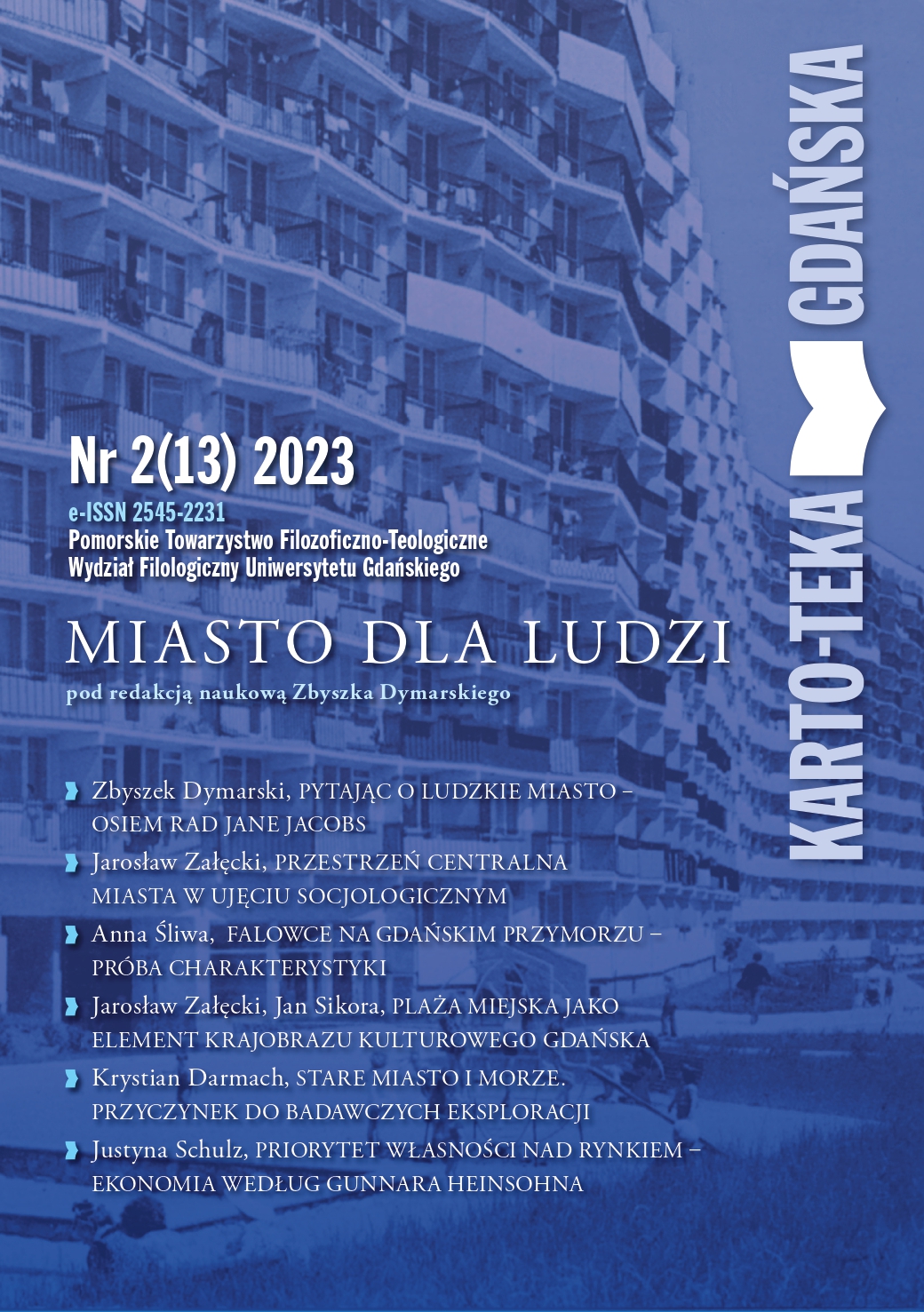Asking about a Human City – Eight Pieces of Advice by Jane Jacobs
DOI:
https://doi.org/10.26881/kg.2023.2.01Keywords:
city for people, Jane Jacobs, Le Corbusier, Ebeznard Howard, ideal city, urban practices, urban diversity, city pavementAbstract
According to the author the most important criteria of evaluating cities are those that take into account the needs and expectations of their inhabitants, who are their most important users. Ebeznard Howard and Le Corbusier thought that it was possible to invent, design and arrange a city in advance, according to a single idea. The failures of their projects demonstrated the fallacy of this approach. According to Jane Jacobs, observing urban life and practicing it is the best starting point for developing criteria for evaluation of the city. This approach leads to an appreciation of the role of the pavement, a leisurely street, frontage buildings and the multifunctionality of quarters. Their proper functioning stimulates the development of neighbourly and social bonds. It makes the city a human city.
Downloads
References
Baines D., Migration in a Mature Economy Emigration and Internal Migration in England and Wales 1861–1900, Cambridge 1986.
Cairo R. A., The Power Broker. Robert Moses and the Fall of New York, New York 2019.
Dygasiński A., Upośledzeni i wybrani, Warszawa 1887.
Dymarski Z., Miejskość i budowanie tożsamości człowieka. Polskie doświadczenia, w: Z. Dymarski, Człowiek i miasto. Gdańszczanie między starą a nową tożsamością, Gdańsk 2017, s. 9–31.
Dymnicka M., Rozwadowski T., Miasto w reżimie konsumpcji, „Estetyka i Krytyka” 2008–2009, nr 15–16, s. 27–40.
Gehl J., Cites for people, Washington 2010.
Gehl J., Życie między budynkami, tłum. M. A. Urbańska, Kraków 2013.
Gehl J., Miasta dla ludzi, tłum. Sz. Nogalski, Kraków 2014.
Helleman G., Wassenberg F., The Renewal of What Was Tomorrow’s Idealistic City. Amsterdam’s Bijlmermeer High-rise, Cities 2004, Vol. 21, No. 1, s. 3–17.
Henderson W. O., The industrialization of Europe 1780–1914, New York 1969.
Hine L. W., Walther P., America at Work, Köln 2018.
Howard E., Miasta-ogrody jutra, tłum. M. Trykozko, Warszawa–Gdańsk 2015.
Jacksen K. T., Crabgrass Frontier. The Suburbanization of the United States, New York–Oxford 1985.
Jacobs J., The Death and Life of Great American Cities, New York 1961.
Jacods J., Śmierć i życie wielkich miast Ameryki, tłum. Ł. Mojsak, Warszawa 2014.
Jacobs J., Śródmieście jest dla ludzi, tłum. W. Kasperski, w: taż, Wielkie i małe plany. Zbiór krótkich tekstów, Warszawa 2017, s. 127–144.
Kajdanek K., Suburbanizacja po polsku, Kraków 2012.
Kubicki P., Wynajdywanie miejskości, Kraków 2016.
Lamparska M., Miasto indyjskie czy modernistyczne? Atrakcyjność turystyczna Chandigarah w Indiach, „Acta Geographica Silesiana” 2016, t. 21, s. 51‒62.
Le Corbusier, Architektura albo rewolucja, w: tenże, W stronę architektury, tłum. T. Swoboda, Warszawa 2012, s. 289–309.
Le Corbusier, Karta Ateńska, tłum. K. Szeronos, T. Swoboda, Warszawa 2017.
Leśniak-Rychlak D., Nigdy nie należy być zbytnim realistą, w: E. Howard, Miasta-ogrody jutra, tłum. M. Trykozko, Warszawa–Gdańsk 2015, s. 7–24.
Long J., Rural-Urban Migration and Socioeconomic Mobility in Victorian Britain, „Journal of Economic History” 2005, No. 1, s. 1–35.
Perry C., Housing for the Mechanic Age, New York 1939.
Pinker M., Mitologizacja, propaganda czy zapis dziejów? O zakładaniu miast arabsko-muzułmańskich, Warszawa 2017.
Rakowska J., Codzienne dojazdy do pracy jako ekonomiczne kryterium rządowych kwalifikacji i delimitacji obszarów, „Studia Regionalne i Lokalne” 2014, nr 3, s. 46–59.
Reymont W., Ziemia obiecana, Warszawa 1899.
Riis J. A., How the Other Half Lives – Studies Among the Tenements of New York, New York 1890.
Smil V., Energia i cywilizacja. Tak tworzy się historia, tłum. J. Sugiero, Gliwice 2022.
Szczotok E., Kościół a kwestia robotnicza w XIX wieku, „Śląskie Studia Historyczno-Teologiczne” 1981, t. 14, s. 175–196.

 Academic Scientific Journals
Academic Scientific Journals

